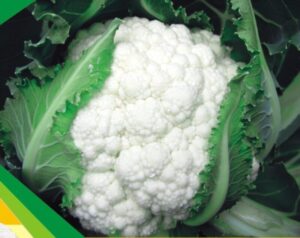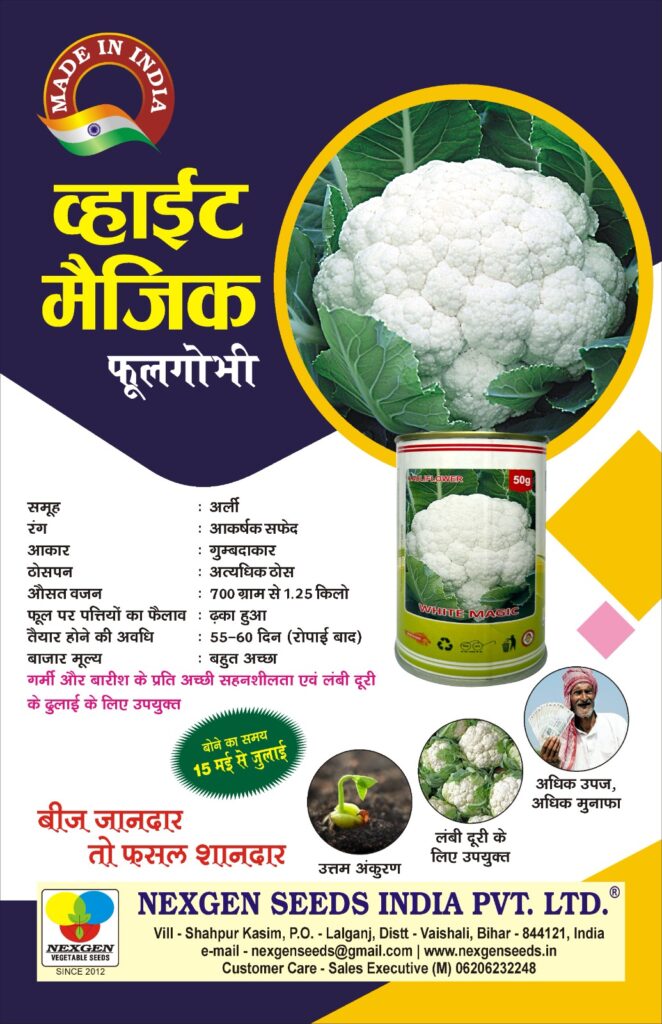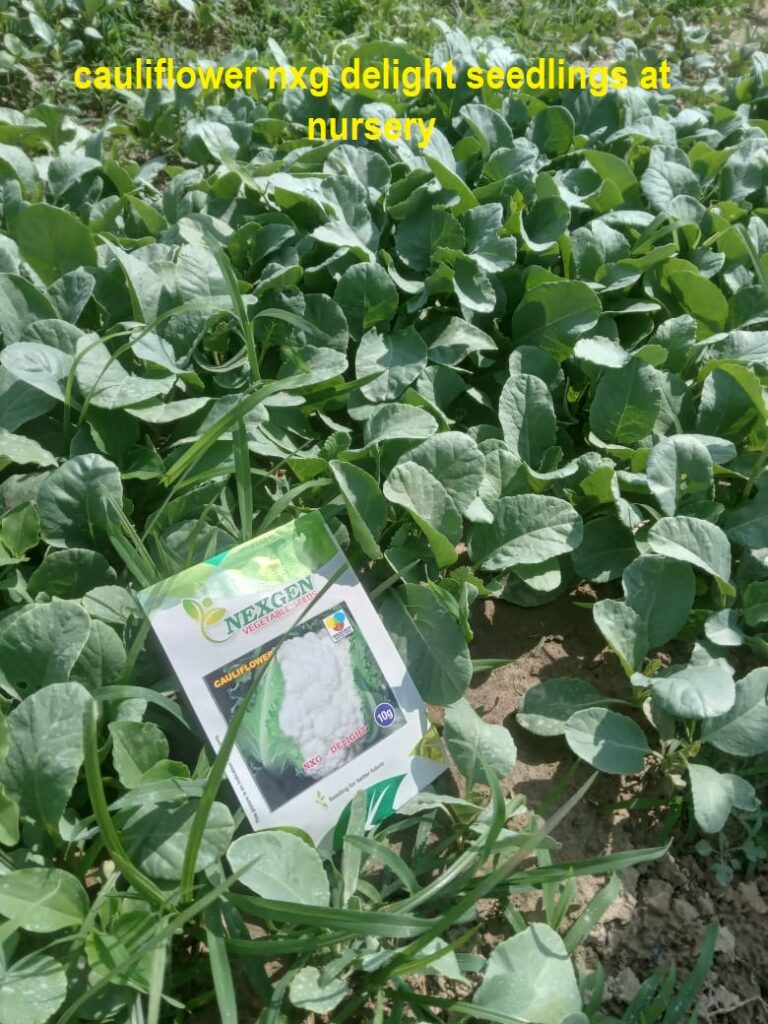
Introduction:
Cauliflower, the versatile cruciferous vegetable, holds a special place in the hearts of gardeners and food enthusiasts alike. Its mild flavour and delicate texture make it a favourite addition to dishes ranging from comforting soups to mouthwatering stir-fries. If you’ve ever dreamed of cultivating your own supply of fresh, nutritious cauliflower, then you’re in for a treat. In this guide, we’ll walk you through the ins and outs of cauliflower gardening, from soil preparation to harvest and beyond.
Quick Facts:
Before diving into the nitty-gritty, let’s explore some quick facts about cauliflower. Did you know that cauliflower is a member of the Brassica family, which also includes broccoli, cabbage, and kale? This cool-season vegetable thrives in temperatures ranging from 60 to 70°F (15 to 21°C) and requires an average of 1 to 1.5 inches (2.5 to 3.8 cm) of water per week. With these basic facts in mind, let’s delve into the essential steps for successful cauliflower gardening.
Soil pH and Fertility:
Creating the right environment for your cauliflower plants begins with understanding soil pH and fertility. Cauliflower prefers slightly acidic soil with a pH ranging from 6.0 to 7.0. Conducting a soil test will help you determine the pH level and identify any nutrient deficiencies. Depending on the results, you can amend the soil with organic matter or specific fertilizers to provide the optimal growing conditions for your cauliflower crop.
Planning Your Cauliflower Crop:
Proper planning is essential for a successful cauliflower harvest. Start by selecting a suitable location that receives full sun and has well-draining soil. Consider spacing requirements, as cauliflower plants typically need 18 to 24 inches (45 to 60 cm) of space between each other. Additionally, keep in mind that cauliflower is a cool-season crop, so plan your planting dates accordingly.
Starting Seeds Indoors:
To give your cauliflower plants a head start, you can start the seeds indoors 4 to 6 weeks before the last frost date in your region. Use seed trays or pots filled with seed starting mix, and keep them in a warm, well-lit area. Once the Cauliflower seedlings have developed a few true leaves, they can be transplanted into the garden.
Direct Seeding:
Alternatively, you can sow cauliflower seeds directly in the garden. Prepare the soil by removing any unwanted plants or weeds and loosening it with a garden tiller or fork. Create furrows about 1/4 inch (0.6 cm) deep and space the seeds according to the package instructions. Cover the cauliflower seeds with soil and water gently.
How to Keep Your Cauliflower Plants Healthy and Produce a big Heads:
Now that your cauliflower plants are growing, it’s crucial to provide them with proper care to ensure their health and productivity. Adequate watering is essential for healthy cauliflower plants, especially during dry spells. Maintain a consistent moisture level, avoiding both overwatering and underwatering. Applying a layer of mulch around the cauliflower seed plants can help retain moisture and suppress weed growth.
Controlling Weeds:
Weeds can compete with cauliflower plants for nutrients and water, hampering their growth. Regularly inspect your garden and remove any weeds that sprout near your cauliflower plants. Mulching can also aid in weed control, as mentioned earlier.
Maximizing Yield with Cauliflower Seeds in India
Blanching:
Blanching is an essential technique for cultivating cauliflower with its characteristic white heads. About two to three weeks before the heads are expected to form, gather the outer leaves of the plant and gently tie them together using twine or rubber bands. This process shields the developing heads from direct sunlight, preventing them from turning yellow or brown. Remember to keep an eye on the plants and remove any insects or pests that may have taken refuge within the leaf bundles.
Harvest and Storage:
The moment of truth arrives when it’s time to harvest your cauliflower. Wait until the heads reach their desired size and are firm and compact. Use a sharp knife to cut the heads off the stalk, leaving a few leaves attached. Be careful not to damage neighbouring plants or the remaining stalk, as they may produce side shoots known as “broccolinis” for extended harvests. Store the harvested cauliflower heads in a cool, dry place or refrigerate them for up to a week.
Managing Cauliflower Insects and Pests:
As with any garden crop, cauliflower faces its fair share of insect pests. Some of Common culprits include aphids, flea beetles, and cabbage worms. Regularly inspect your plants for signs of infestation, such as chewed leaves or sticky residue left by aphids. To manage these pests, you can employ natural methods like handpicking, installing physical barriers, or introducing beneficial insects like ladybugs or praying mantises. If the infestation becomes severe, consider organic insecticides as a last resort.
Managing Cauliflower Diseases and Disorders:
Cauliflower is susceptible to various diseases and disorders that can hinder its growth. Common culprits include black rot, clubroot, and downy mildew. To prevent these issues, practice crop rotation, ensure proper drainage, and provide adequate air circulation by spacing your plants appropriately. If you notice any symptoms or signs of disease, promptly remove and dispose of affected plants to prevent further spread. Utilizing disease-resistant cultivars can also help mitigate the risk.
Conclusion:
Congratulations! You’ve now gained a comprehensive understanding of cauliflower gardening. By following the steps outlined in this guide, you’ll be well on your way to growing your own bountiful and delicious cauliflower crop. Remember to provide your plants with the right conditions, manage pests and diseases diligently, and enjoy the rewards of your labour when you Savor the taste of homegrown cauliflower in your favourite recipes. Happy gardening!

Managing Cauliflower Disorders and Symptoms:
In addition to pests and diseases, cauliflower can also be affected by various disorders that manifest in different symptoms. It’s important to be aware of these disorders and take necessary measures to manage them effectively.
One common disorder in cauliflower is “buttoning,” which occurs when the heads of the cauliflower form prematurely into small, undeveloped buttons. This can be caused by stress factors such as extreme temperatures, inadequate fertility, or insufficient water. To prevent buttoning, ensure that your cauliflower plants receive consistent and appropriate care, including proper watering and adequate nutrition.
Another disorder to watch out for is “hollow stem.” As the name suggests, this condition causes a hollow space to form in the stem of the cauliflower head. It is often caused by rapid growth during periods of high temperatures. To minimize the risk of hollow stem, provide your plants with consistent moisture and avoid sudden temperature fluctuations. Additionally, maintaining optimal spacing between plants can promote good air circulation and reduce the likelihood of this disorder.
Cauliflower can also be susceptible to “riciness,” where the curds become grainy or have a rice-like texture instead of the desired smooth and compact florets. This can occur due to various factors, including high temperatures, nutrient deficiencies, or irregular watering. To prevent riciness, maintain an even moisture level in the soil, provide adequate nutrition through proper fertilization, and avoid exposing the plants to excessive heat.
Lastly, another disorder to be mindful of is “button rot.” This condition is characterized by the development of soft, sunken spots on the cauliflower heads, which eventually turn brown and rot. Button rot can be caused by a combination of factors, including excess moisture or poor air circulation, which create favourable conditions for fungal growth. To prevent button rot, ensure proper drainage in your garden and avoid overwatering. Providing adequate spacing between plants and promoting good air circulation can also help prevent this disorder.
By being aware of these disorders and their symptoms, you can take proactive measures to prevent or manage them effectively. Regular observation, proper care, and timely action are key to maintaining healthy and productive cauliflower plants.
Conclusion:
Cauliflower gardening may initially seem daunting, but with the right knowledge and approach, it can be a rewarding and enjoyable experience. From preparing the soil to savouring the harvest, every step in the process contributes to your success as a cauliflower gardener. By understanding the basics of soil pH, fertility, seed starting, and plant care, you can set yourself up for a thriving cauliflower crop. Remember to stay vigilant against pests, diseases, and disorders, taking necessary steps to manage them effectively. With dedication and a little bit of green thumb, you’ll be able to enjoy the satisfaction of growing your own delicious and nutritious cauliflower. Happy gardening!
यह भी पढ़ें: फूलगोभी की वैज्ञानिक खेती सम्पूर्ण जानकारी !
Top 20 frequently asked questions and answers about cauliflower gardening made easy for beginners, covering various aspects from soil preparation to pest management:
- What are some quick facts about cauliflower gardening?
Cauliflower (Brassica oleracea) is a cool-season vegetable that belongs to the Brassicaceae family. It is rich in vitamins and minerals, and it comes in various colours, including white, purple, and orange.
- How does soil pH and fertility affect cauliflower growth?
Cauliflower prefers slightly acidic to neutral soil with a pH range of 6.0 to 7.0. Adequate soil fertility is essential for healthy plant growth and high-quality cauliflower heads. Adding organic matter, such as compost, can improve soil fertility and balance the pH Level.
- Why is soil testing important for cauliflower gardening, and how should I fertilize accordingly?
Soil testing helps determine the nutrient levels and pH of your soil. Based on the test results, you can apply fertilizers specific to the nutrient deficiencies. Generally, a balanced fertilizer with a higher nitrogen content is beneficial for cauliflower growth.
- How should I plan my cauliflower crop?
Plan your cauliflower crop by considering the growing season, temperature requirements, and available space in your garden. Make sure to rotate cauliflower with other crops to reduce the risk of diseases and pests.
- Can I start cauliflower seeds indoors, and how?
Yes, you can start cauliflower seeds indoors. Begin sowing seeds in trays or pots about 6-8 weeks before the last expected frost. Provide adequate light, warmth, and moisture for successful germination.
- Is direct seeding an option for cauliflower?
Direct seeding is possible for cauliflower, especially in regions with a long growing season. Sow seeds directly into well-prepared soil after the danger of frost has passed. Thin the cauliflower seedlings to maintain proper spacing.
- How can I keep my cauliflower plants healthy and productive?
To keep your cauliflower plants healthy and productive, provide them with consistent moisture, adequate sunlight, and proper air circulation. Mulching technique can help retain and maintain soil moisture and suppress weeds growth.
- How often should I water my cauliflower plants?
Water cauliflower plants deeply and regularly, providing about 1-1.5 inches of water per week. Adjust watering occurrence based on weather conditions. Confirm the soil is evenly moist but not waterlogged.
- What are some effective ways to control weeds in cauliflower gardening?
Mulching with organic materials like straw or wood chips can help suppress weeds in cauliflower beds. Hand pulling or hoeing weeds when they are small is also effective. Avoid using chemical herbicides near cauliflower plants.
- What is blanching, and why is it necessary for cauliflower?
Blanching is the process of covering cauliflower heads to protect them from sunlight. It prevents the heads from turning yellow or developing an unpleasant taste. Secure the outer leaves over the heads when they reach a suitable size.
- When is the right time to harvest cauliflower, and how should I store it?
Harvest cauliflower heads when they reach a suitable size and are firm and compact. Cut the cauliflower heads with a sharp knife, leaving a short stem. Store harvested cauliflower in a cool, moist place or refrigerate it for up to a week.
- How can I manage insects that affect cauliflower plants?
To manage insects like aphids, cabbage worms, or flea beetles, you can use organic insecticides, insecticidal soaps, or neem oil. Additionally, encouraging beneficial insects such as ladybugs and lacewings can help control pest populations naturally. Regularly inspect your plants for any signs of insect damage and take appropriate action.
- What are some common symptoms and damage caused by cauliflower pests?
Common symptoms of cauliflower pests include chewed leaves, holes in the foliage, stunted growth, and wilting. Pests like cabbage worms leave behind green droppings, while aphids may cause distorted or curled leaves.
- How can I manage cauliflower diseases and their symptoms?
To manage cauliflower diseases such as black rot or clubroot, practice crop rotation and avoid planting cauliflower in the same spot year after year. Ensure good air circulation around plants, as some diseases thrive in humid conditions. Remove and destroy infected plants to prevent the spread of diseases.
- What are some common symptoms and damage caused by cauliflower diseases?
Cauliflower diseases can cause symptoms such as yellowing or browning of leaves, rotting of the base or roots, and the formation of dark lesions on the stems. Infected plants may exhibit stunted growth and produce poor-quality heads.
- How can I manage cauliflower disorders and their symptoms?
Cauliflower disorders like buttoning (small, undeveloped heads) or hollow stem can be managed by providing consistent moisture and avoiding extreme temperature fluctuations. Adequate spacing between plants and proper nutrition can also help prevent these disorders.
- What are some common symptoms and damage caused by cauliflower disorders?
Cauliflower disorders can result in small, malformed heads, heads that fail to develop fully, or hollow stems. Environmental factors, nutrient imbalances, or inconsistent watering can contribute to these disorders.
- Are there any organic methods to manage cauliflower pests, diseases, and disorders?
Yes, organic methods can be effective in managing cauliflower pests, diseases, and disorders. These include using organic insecticides, practicing crop rotation, providing proper plant nutrition, maintaining good hygiene in the garden, and using natural remedies like neem oil or garlic spray.
- How can I prevent the recurrence of pests, diseases, and disorders in my cauliflower garden?
To prevent the recurrence of pests, diseases, and disorders, it is essential to maintain good garden hygiene, rotate crops, remove and destroy infected plant material, and monitor your garden regularly for early signs of problems. Additionally, selecting disease-resistant cauliflower varieties can be beneficial.
- Where can I find more information and resources on cauliflower gardening?
For more information and resources on cauliflower gardening, you can consult gardening books, reputable gardening websites, local agricultural extension offices, or join online gardening communities where you can connect with experienced gardeners and seek their advice and suggestions.
Remember, successful cauliflower gardening requires patience, attention to detail, and proactive management of potential issues. With the right knowledge and care, you can enjoy a bountiful harvest of delicious and nutritious cauliflower!
Grow More: Growing Cauliflower in Containers 6 Tips and Tricks

